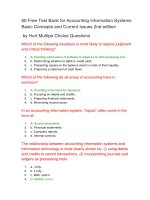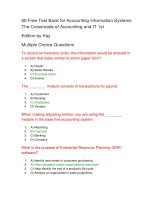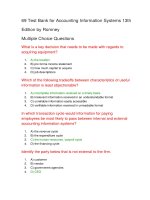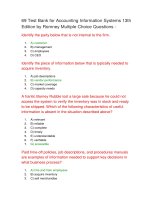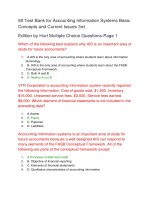85 test bank for accounting information systems the crossroads of accounting and IT 1st edition
Bạn đang xem bản rút gọn của tài liệu. Xem và tải ngay bản đầy đủ của tài liệu tại đây (110.45 KB, 27 trang )
85 Test Bank for Accounting Information Systems The
Crossroads of Accounting and IT 1st Edition
True - False Questions
A database may have two or more tables with the exact same name.
1.
True
2.
False
The enterprise-wide view of accounting enables the accountant to see how
the accounting system interacts with other subsystems in the enterprise
system.
1.
True
2.
False
A primary key may be used to associate customer information (name,
address, phone number, etc.) with a sales order.
1.
True
2.
False
Understanding how the data will be used is essential when designing a
database.
1.
True
2.
False
A Supply Chain Management (SCM) system is a subsystem of an Accounting
System.
1.
True
2.
False
The Financial Module of a baseline accounting system includes payroll
transactions.
1.
True
2.
False
Data cubes allow you to view data in two dimensions.
1.
True
2.
False
The Customer Module of a baseline accounting system includes creating
purchase orders.
1.
True
2.
False
The database is a key component of an accounting system.
1.
True
2.
False
Enterprise Resource Planning (ERP) software focuses on integrating
information flows across an entire enterprise.
1.
True
2.
False
An IT auditor must understand the terms and definitions used by accounting
and IT professionals.
1.
True
2.
False
Private companies (companies that are not publicly traded) are not required to
have their internal controls assessed by an independent CPA firm.
1.
True
2.
False
An integrated enterprise system allows different departments to use the same
information.
1.
True
2.
False
Business Intelligence tools use queries to extract data directly from the
relational database, bypassing the OLAP cube and any accompanying delay.
1.
True
2.
False
Database queries search the database to answer a specific question and
extract information from one or more tables.
1.
True
2.
False
An IT audit includes auditing the System Development Life Cycle (SDLC).
1.
True
2.
False
Only internal users, for example accountants, directors, and executives, may
use an integrated enterprise system.
1.
True
2.
False
IT infrastructure is the design of an organization's information technology.
1.
True
2.
False
Spreadsheet software can be used to perform analysis on data the cannot be
done within a relational database.
1.
True
2.
False
A database record is a collection of related database tables.
1.
True
2.
False
Multiple Choice Questions - Page 1
Which of the following is the best way to protect information assets?
1.
A) Limit the number of users that can access the data at the same time to 5 people.
2.
B) Implement policies and procedures for data deletion (destruction).
3.
C) Limit the amount of time a user may access the data.
4.
D) Require an ID and password to access data in the databases.
Which of the following data is shared between a Customer relationship
management system and an accounting system?
1.
A) Employee information
2.
B) The advertising costs
3.
C) The cost of goods sold
4.
D) Vendor information
The ________ module in the Baseline Accounting System consists of
transactions such as the purchasing of goods or services from a vendor.
1.
A) Customers
2.
B) Banking
3.
C) Employees
4.
D) Vendors
When looking at an accounting system using the zoom view, you see
1.
A) Accounting information available to internal users, primarily management
2.
B) Detailed information recorded in the accounting system
3.
C) An enterprise-wide view of an organization showing the entire accounting system
4.
D) Information available on the tax reports for the Internal Revenue Service and other
tax agencies
To record an inventory order, the information would be entered in a screen
that looks similar to which paper form?
1.
A) Check
2.
B) Sales Receipt
3.
C) Purchase Order
4.
D) Invoice
What is an alternative to "hard keyed" data?
1.
A) Using variables in the program, such as cell addresses in a spreadsheet
2.
B) Creating the program in a way that does not require data
3.
C) If user requirements are correctly defined, the data will not change and may be
"hard keyed."
4.
D) Alternatives to "hard keyed" data is not possible. All data must be "hard keyed."
When data is "hard keyed" into the program, which of the following is true?
1.
A) Changing the data is cost efficient and may be accomplished in a matter of minutes.
2.
B) Changing the data is costly and may take days or weeks.
3.
C) Changing the data requires purchasing additional computer storage and may take
days or weeks.
4.
D) Changing the data requires recreating (recoding) the entire program.
Which transactions are usually performed in the Customers module of the
Baseline Accounting System?
1.
A) Pay Bills
2.
B) Create Purchase Order
3.
C) Create Invoice
4.
D) Receive Inventory
When making adjusting entries, you are using the ________ module in the
base line accounting system.
1.
A) Reporting
2.
B) Financial
3.
C) Banking
4.
D) Company
When looking at an accounting system using the aerial view, you see
1.
A) Accounting information available to internal users, primarily management
2.
B) Detailed information recorded in the accounting system
3.
C) An enterprise-wide view of an organization showing the entire accounting system
4.
D) Information available on the tax reports for the Internal Revenue Service and other
tax agencies
Which accounting software is designed for a large-scale company?
1.
A) SAP Business All-in-One
2.
B) SAP Business One
3.
C) Oracle's JD Edwards EnterpriseOne
4.
D) Oracle's PeopleSoft Enterprise
Which of the following data is shared between a operations/production
system and an accounting system?
1.
A) The cost of the raw materials
2.
B) The monthly sales levels
3.
C) The current inventory levels of the finished product
4.
D) Customer information
The three basic functions of an enterprise system are
1.
A) Processing, Output, and Reports
2.
B) Input, Data, and Reports
3.
C) Input, Processing, and Output
4.
D) Business Intelligence, Processing, and Output
What is the main benefit of a company giving vendors access to the
enterprise system?
1.
A) To suggest new products to sell
2.
B) To help test the system security
3.
C) To provide suggestions on improving the enterprise system
4.
D) To coordinate inventory deliveries
The reports module produces for the following people except
1.
A) Investors
2.
B) Managers
3.
C) Accountants
4.
D) Customers
An accounting system spans which of the following Value Chain
components?
1.
A) Support
2.
B) Purchase
3.
C) Customers
4.
D) All the above except C.
The purchasing cycle consists of transactions between which entities?
1.
A) A company and vendors
2.
B) A company and employees
3.
C) A company and customers
4.
D) A company and a bank
The ________ module consists of transactions for payroll.
1.
A) Customers
2.
B) Banking
3.
C) Employees
4.
D) Vendors
To record a payment for inventory delivered, the information would be entered
in a screen that looks similar to which paper form?
1.
A) Check
2.
B) Sales Receipt
3.
C) Purchase Order
4.
D) Invoice
Which of the following data is shared between a Supply Chain Management
system and an accounting system?
1.
A) The sale price of the finished product
2.
B) The current inventory levels of the raw materials
3.
C) The product delivery costs
4.
D) The number of hours employees worked to create the product
What is the purpose of an onscreen entry form?
1.
A) Onscreen entry forms help ensure information is entered only once in the database.
2.
B) Onscreen entry forms provide a familiar interface for entering information into a
database.
3.
C) Onscreen entry forms allow you perform data analysis that is cumbersome in a
relational database.
4.
D) Onscreen entry forms provide predictive modeling to gain insights from data to
improve business decisions.
Which event is part of the Purchasing Cycle?
1.
A) Enter Bill
2.
B) Pay Bill
3.
C) Make Deposit
4.
D) Create Invoice
What modules comprise a baseline accounting system?
1.
A) Vendors, Employees, Sales, Banking, Financial, and Reports
2.
B) Inventory, Employees, Sales, Banking, Financial, and Reports
3.
C) Inventory, Employees, Sales, Banking, Accounting, and Reports
4.
D) Vendors, Employees, Customers, Banking, Financial, and Reports
Which event is part of the Sales Cycle?
1.
A) Receive Item
2.
B) Enter Time
3.
C) Make Deposit
4.
D) Create Purchase Order
What is the purpose of Enterprise Resource Planning (ERP) software?
1.
A) Identify new trends in consumer purchasing
2.
B) Help managers control organizational resources
3.
C) Help identify the end of a product's life cycle
4.
D) Analyze an organization's sales projections
Which of the following professionals is the most important group an IT auditor
must be able to communicate?
1.
A) Accounting and Human Resource professionals
2.
B) IT and Sales professionals
3.
C) Accounting and IT professionals
4.
D) Sales and Human Resource professionals
50 Free Test Bank for Accounting Information Systems
The Crossroads of Accounting and IT 1st Edition by Kay
Multiple Choice Questions - Page 2
Which of the following agents is internal to a company?
1.
A) Investor
2.
B) Customer
3.
C) Employee
4.
D) Vendor
When designing a database, which field would not belong in a table storing
inventory information?
1.
A) Part Number
2.
B) Purchase Order
3.
C) Sale Price
4.
D) Cost
To find patterns in data you would use
1.
A) A spreadsheet application
2.
B) Business intelligence applications
3.
C) Flat file
4.
D) All the above except C
When designing a database, which field would not belong in a table storing
customer information?
1.
A) Zip Code
2.
B) Street Address
3.
C) Last Name
4.
D) Order Number
Online Analytical Processing (OLAP) cubes allow you to
1.
A) View the same data from just one perspective
2.
B) Manipulate data in a spreadsheet
3.
C) View the same data from different perspectives
4.
D) Add data to the database
Spreadsheets containing data extracted from a relational database are called
what?
1.
A) Ghost Data
2.
B) Intelligent Data
3.
C) Shadow Data
4.
D) Gray Data
Which field below would not be stored in an order table?
1.
A) Order ID
2.
B) Item ID
3.
C) Vendor ID
4.
D) Customer ID
IT ________ is the design or blueprint for an enterprise's information
technology.
1.
A) Infrastructure
2.
B) Architecture
3.
C) Technology
4.
D) Network
In a relational database, how are tables connected?
1.
A) By fields that are common in two or more tables
2.
B) By the table names
3.
C) By a query statement
4.
D) By network addresses
Which act requires publicly traded companies to assess the effectiveness of
their internal controls and have an independent CPA firm audit this
assessment?
1.
A) Wheat Commission
2.
B) Sarbanes-Oxley Act of 2002
3.
C) Security Exchange Commission Act of 1934
4.
D) The GAAP Act of 1932
Which of the following processes are performed in the Designing Phase of the
SDLC?
1.
A) Identify the requirements for the new system
2.
B) Test the new system
3.
C) Identify the new business processes
4.
D) Install the new system
In an accounting system database, which field belongs in a table containing
inventory information?
1.
A) Invoice Number
2.
B) Purchase Order
3.
C) Vendor ID
4.
D) City
The following fields are common to tables storing customer, vendor, and
employee information except?
1.
A) Area Code
2.
B) City
3.
C) State
4.
D) Cost
What are the three key factors to consider for a successful accounting
system?
1.
A) People, Processes, and Technology
2.
B) People, Budget, and Time
3.
C) Processes, Budget, and Time
4.
D) Time, Processes, and Technology
How much time do accountants spend using spreadsheets?
1.
A) 30%
2.
B) 50%
3.
C) 80%
4.
D) 90%
The staffing process occurs in which phase of the SDLC?
1.
A) Plan Phase
2.
B) Analyze Phase
3.
C) Build/Buy Phase
4.
D) Deploy Phase
The following field names are part of a table for a company's inventory. Which
field name could be the primary key for this table?
1.
A) Vendor ID
2.
B) Item ID
3.
C) Cost
4.
D) Sales Price
Which of the following is not a phase in the SDLC?
1.
A) Buy
2.
B) Design
3.
C) Plan
4.
D) Sell
Analyzing the impact an accounting system will have on people should occur
in which phase of the SDLC?
1.
A) Planning
2.
B) Analyze
3.
C) Design
4.
D) Deploy
When designing an accounting database, where should you begin?
1.
A) With the outcome in mind
2.
B) The accounting software
3.
C) The paper forms
4.
D) The development phase of the software development life cycle
What is the purpose of a database query?
1.
A) To provide a format for viewing data
2.
B) To search the database to answer a specific question
3.
C) To connect related tables
4.
D) To uniquely identify a record in a database table
In an accounting system database, which field belongs in a table containing
customer information?
1.
A) Item Number
2.
B) Street Address
3.
C) Invoice Number
4.
D) Cost
What is the purpose of security and controls over information assets?
1.
A) Security and controls are to prevent fraud, unauthorized access, modification,
destruction, or disclosure of information assets.
2.
B) Security and controls are to prevent data analysis.
3.
C) Security and controls are to frustrate employees with legitimate need to access
information assets.
4.
D) Security and controls are to ensure all the information assets are available to all
employees.
A ________ is a collection of related database tables.
1.
A) Field
2.
B) Relational Database
3.
C) Operational Database
4.
D) Primary Key
Free Text Questions
What types of data does an operations/production system and an accounting
system need to share? How does each system use that data?
Answer Given
An operations/production system and an accounting system would share production
employee information, work in process, and the current level of finished product. (The
student may provide additional types of data.). The operations/production system uses
the employee information to estimate production capacity. The work in process and
current level of finished product issued to calculate needed production rate. The
accounting system uses the employee data to run payroll. The work in process and
current level of finished product is used in various financial reports.
What types of data does a Supply Chain Management system and an
accounting system need to share? How does each system use that data?
Answer Given
A Supply Chain Management system and an accounting system would share vendor
information (company name, primary contact, address, and phone number), items
supplied by the vendor, purchase orders, delivery dates, delivery receipt., and current
raw material inventory levels. (The student may provide additional types of data.). The
Supply Chain Management system uses this information to order more supplies and
verify delivery content. Raw material inventory levels are used to calculate when to
order more raw materials. The accounting system uses this data to know which vendor
to pay, how much to pay the vendor, and when to pay the vendor. Raw material
inventory is used in various financial reports.
You are an accountant and one of your clients is a small business that sells
only over the Internet. How would you convince the owner to purchase an
integrated enterprise system?
Answer Given
The answer should include the following information: - SCM: items are automatically
removed from inventory and calculations made for reordering from vendors, identify
fast moving items (keep reordering from vendor ) or slow moving items (consider
removing from inventory); - CRM: the purchase is analyze for trends, products
purchased at a particular time of day and/or day of the week, analyze for more
targeted marketing (coupons); - Operations/Production System: track shipping
supplies; - Human Resources Planning: track appropriate personnel positions
(more/less people for gathering items in the purchase, more/less people for packaging
the purchase, more/less people in the shipping department, etc.)
How can data in an accounting information system improve decision making?
Provide examples of these decisions.
Answer Given
Data in an accounting information system can improve decision making by being
transformed into information. With further analysis, that information is transformed in to
business intelligence. Business intelligence can help a business predict what type of
new product customers will buy next year and/or what type of existing product
customers will stop buying next year. It can help a business increase sales and reduce
returns. Business intelligence can help investors decide if they should invest in the
company or sell any existing investments in company. Business intelligence can help
banks decide if they should loan the company money.
If you were the person entering transactions into an accounting system, why
would you want the input screens to look like paper forms?
Answer Given
Input screens that mirror paper forms provide a familiar interface for entering data.
This reduces the amount of time needed to learn how to enter data and learn the
system. The familiarity also helps the user to become comfortable with the system.
You are an intern at a small mom-and-pop type corner grocery store. The
owner's accountant is trying to talk the owners into purchasing an integrated
enterprise system for small businesses. The owner thinks the accountant is
just trying find a way to charge more money. How would you convince the
owner each piece of the integrated enterprise system would help the
business?
Answer Given
The answer should include the following information: - Supply Chain Management:
items are automatically removed from inventory and calculations made for reordering
from vendors, identify fast moving items (keep reordering from vendor ) or slow
moving items (consider removing from inventory); - Customer Relationship
Management: the purchase is analyze for trends, products purchased at a particular
time of day and/or day of the week, analyze for more targeted marketing (coupons); Operations/Production System : track items from the meat counter/deli/bakery to know
when to order inputs (flour, sugar, various meat products, etc.); - Human Resources
Management: track appropriate personnel positions (more/less bakers, more/less
butchers, more/less sales clerks, more/less stockers, etc.)
How are database tables connected in a relational database? How does this
help prevent entering data multiple times? Please provide an example.
Answer Given
Database tables in a relational database are connected by fields that are common to
two or more tables. The common field is usually the primary key for one of the tables.
This connection helps prevent entering data multiple times by associating data in one
table with data in another table. For example, customer information is usually stored in
a table (Customer) with a primary key (Customer ID) and sales order (Order)
information are stored in another table with a primary key (Order NO). By including a
field for Customer ID in the Order table, the Order table and Customer table are
connected. (The student may provide a different example.)
Identify the six modules in the baseline accounting system. Which transaction
cycle is associated with each module? What type of transactions are
associated with each module?
Answer Given
- Vendor module — consists of transactions with vendors; this module relates to the
purchasing cycle; - Customer module — consists of transactions with customers; this
module relates to the sales cycle; - Employee module — consists of transactions with
employees for payroll; this module relates to the payroll cycle; - Banking module —
involves cash received (deposits) and cash paid (checks/withdrawals) with the
enterprise's bank; this modules does not relate to a transaction cycle; - Financial
module — consists of other transactions that are not part of the other modules; for
example, adjusting entries, correcting entries, and closing entries; this module relates
to the financial cycle; - Reports module — consists of output from the Accounting
system (hard copies and soft copies); for example financial reports, tax reports, and
management reports; this module does not relate to a transaction cycle.
What are the results of using "hard keyed" data in a program and why? Please
provide an example.
Answer Given
Using "hard keyed" data in a program results in a program with limited or no flexibility
and is costly to update. "Hard keyed" data is any data that a programmer/developer
inserts directly into the program code. It becomes part of the program. For example, if
a programmer creates a program to calculate monthly mortgage payments and hard
keys 5% for the interest rate and 30 years for the loan length, the program will not be
useful for loans with a different interest rate or for a different amount of time. (The
student may provide a different example.)
You are hired by a consulting company to assist in creating an accounting
system for a company that sells exclusively online. List the fields needed for
the Customer table and the Inventory table. Identify the primary key in each
table.
Answer Given
Customer table: Customer ID (primary key), First Name, Last Name, Street Address,
City, State, ZIP Code, Cell Area Code, Cell Phone, Home Area Code, Home Phone
Number, Work Area Code, Work Phone Number, Email Address, Contact Preference
(the student may have additional fields). Inventory table: Item Number (primary key),
Item Name, Primary Vendor ID, Secondary Vendor ID, Cost, Sale Amount, Amount On
Hand, Amount On Order, Warehouse ID, Location in Warehouse (the student may
have additional fields)
What are the three database essentials an accounting professional needs to
know? Define and provide an example of each.
Answer Given
Field - A piece of information about events, people, or objects. Example, phone
number. (The student may provide a different example; Record - A collection of related
fields. Example, customer ID, first name, last name, street address, city, state, zip
code, area code, and phone number. (The student may provide a different example.);
Table - A collection of related records with a unique table name. For example,
Customer. ( The student may provide a different example.)
What may be classified as a information asset? Please provide an example.
Answer Given
Data contained in the information system. For example, electronic records, files, and
databases. Information technology which is defined as hardware such as computers,
servers, routers, keyboards, and monitors (the student may list other hardware) and
software such as firewalls, applications, analysis tools (the student may list other
software).
What are the six main phases in the System Development Life Cycle. What
happens in each phase?
Answer Given
Plan the system project including scheduling, budgeting, and staffing.Analyze the new
system requirements, such as what reports are required and what data needs to be
collected by the system. Design business processes and databases for the new
system. Build/buy and test databases and computer programs for the new
system.Install new IT hardware, software, and databases. Deploy the new system,
using the system on an ongoing basis and maintaining and updating it as necessary.
What is the difference between data, information, and business intelligence?
Answer Given
Data is an individual piece of a larger entity. For example, the amount of a customer's
purchase is data. An individual piece of data is generally not helpful in making
business decisions. Information is a collection of related data. For example, an income
statement. Information provides details about what occurred in the past.Business
intelligence is an analysis of related information. For example, financial analytics and
predictive modeling. Business intelligence helps decision makers make various
predictions such as what customers will buy next year.
What are the advantages and disadvantages of using a shadow data system?
Answer Given
Advantages: - Easier to perform analysis using spreadsheets; - No need to depend on
IT staff to program and run necessary queries Disadvantages; - Spreadsheets have
very little documentation; therefore, when the individual who created it leaves, the
spreadsheet is abandoned or must be recreated; - Spreadsheets may have
inadequate on nonexistent security to prevent unauthorized access


